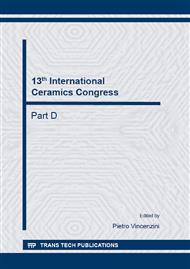[1]
Figueiredo FML, Marques FMB. Electrolytes for solid oxide fuel cells. Wiley Interdisciplinary Reviews: Energy and Environment. 2013; 2(1): 52-72.
DOI: 10.1002/wene.23
Google Scholar
[2]
Wachsman ED, Lee KT. Lowering the Temperature of Solid Oxide Fuel Cells. Science. 2011; 334(6058): 935-9.
DOI: 10.1126/science.1204090
Google Scholar
[3]
Iwahara H, Esaka T, Uchida H, Maeda N. Proton conduction in sintered oxides and its application to steam electrolysis for hydrogen production. Solid State Ionics. 1981; 3–4(0): 359-63.
DOI: 10.1016/0167-2738(81)90113-2
Google Scholar
[4]
Malavasi L, Fisher CAJ, Islam MS. Oxide-ion and proton conducting electrolyte materials for clean energy applications: structural and mechanistic features. Chemical Society Reviews. 2010; 39(11): 4370-87.
DOI: 10.1039/b915141a
Google Scholar
[5]
Truls N. The promise of protonics. Nature. 2001; 410(6831): 877-8.
Google Scholar
[6]
Kreuer KD. On the development of proton conducting materials for technological applications. Solid State Ionics. 1997; 97(1–4): 1-15.
DOI: 10.1016/s0167-2738(97)00082-9
Google Scholar
[7]
Norby T. Proton Conduction in Solids: Bulk and Interfaces. MRS Bulletin. 2009; 34 (12): 923-8.
DOI: 10.1557/mrs2009.214
Google Scholar
[8]
Haile SM, Staneff G, Ryu KH. Non-stoichiometry, grain boundary transport and chemical stability of proton conducting perovskites. Journal of Materials Science. 2001; 36(5): 1149-60.
Google Scholar
[9]
Haile SM, West DL, Campbell J. The role of microstructure and processing on the proton conducting properties of gadolinium-doped barium cerate. Journal of Materials Research. 1998; 13(06): 1576-95.
DOI: 10.1557/jmr.1998.0219
Google Scholar
[10]
Heidari M, Zamaniyan A, SafeKordi A, Ganji Babakhani E, Amanipour M. Effect of Sintering Temperature on Microstructure and Hydrogen Permeation Properties of Perovskite Membrane. Journal of Materials Science & Technology. 2013; 29(2): 137-41.
DOI: 10.1016/j.jmst.2012.12.003
Google Scholar


